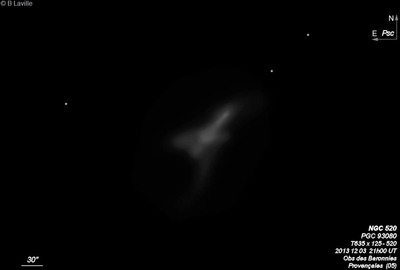
William Herschel discovered NGC 520 = H III-253 = h116 on 13 Dec 1784 (sweep 338) and remarked "eF, cL, E." On 3 Dec 1787 (sweep 788), he reported "cL, E from sp to nf." John Herschel reported on 16 Oct 1827, "pB; E like a comet, pos 135°±; 60" length". Using LdR's 72", Bindon Stoney wrote on 18 Dec 1851, "South end is like a brush or broom with a split in it." His sketch was included in the 1861 publication (as well as 1880). A second observation on 9 Nov 1876 reads "Lord Rosse thought it had two points of condensation 3/4' apart. I (Dreyer) thought it spread out in the following end like a fan. Not well seen." This galaxy is in Arp's category of disturbed galaxies with interior absorption.
200/250mm - 8" (11/28/81): faint, diffuse, elongated N-S.
400/500mm - 17.5" (1/1/92): fairly bright, moderately large, elongated 5:2 NW-SE, 3.0'x1.2'. Very unusual appearance; the NW portion is noticeably brighter with a bright knot at the NW tip and a mottled texture. Fades towards the SE where it merges into a fainter section which is tilted ~E-W with an irregular surface brightness and ill-defined edges.
900/1200mm - 48" (10/22/11): the view of this very bright, highly irregular, disrupted galaxy was fascinating at 488x. The most prominent feature is a very high surface brightness curving "bar" oriented NW-SE (VV 231a), bending out in the middle towards the southwest, and fading out on the southeast end with a faint extension. The total length of the banana-shaped bar is close to 2.5'. The brightest part is at the northwest end, where there is a large, bright knot, 24" diameter that increases to the center. In AJ, 134, 212 (2007), Rossa et all refer to this knot as the northern nucleus. The edge of the bar is very well defined along the north side. At the southeast end of the main bar, the brightness dims sharply but a much fainter hazy glow continues further southeast (VV 231c) and spreads out.
On the south side is a fairly bright, elongated section oriented WNW-ESE (VV 231b), that is separated from the northern "bar" by a prominent, irregular dark lane running NW to SE, paralleling the bar in the central region. A slightly brighter "knot" is located is the middle of the southern section. According to the Rossa paper, the dust lane just north of this knot optically obscures the southern nucleus. At the southeast end, the glow dims rapidly and fans out further southeast.
Notes by Steve Gottlieb